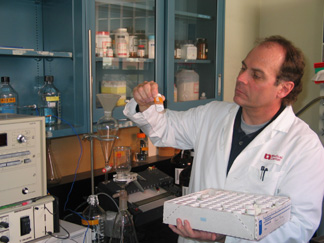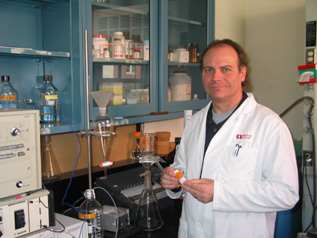 |
 |
Sam Sanderson, Ph.D., is evaluating a variety of synthetic peptides as possible nicotine vaccines. |
Sam Sanderson, Ph.D., knows all about serendipity. A biochemist, Dr. Sanderson was conducting some experiments several years ago to determine how certain tiny molecules called peptides interact with the immune system. One peptide surprisingly jumped out at him in the experiments.
“It caught my attention right away,” said Dr. Sanderson, who is associate professor in the School of Allied Health Professions. “I was intrigued by how it interacted with cell receptors. I knew I was on to something.”
After years of research, that something turned out to be a possible vaccine that would eliminate a smoker’s craving for nicotine. Earlier this month, Dr. Sanderson’s efforts were rewarded with a one-year, $100,000 Small Business Technology Transfer Research (STTR) grant from the National Institute of Drug Abuse.
The STTR grant was awarded to Dr. Sanderson’s own company called Prommune, a spin-off company that was developed through UNeMed, a company created by UNMC for the purpose of getting UNMC research breakthroughs into the marketplace.
The STTR grant is actually a partnership between a for-profit company (Prommune) and a non-profit research institution (UNMC). “The whole idea behind the grant is to bring these two entities together so that promising research discoveries can be put on the fast track,” Dr. Sanderson said. “The hope is that the partnership will allow these products to get into the marketplace sooner and into the hands of people who can benefit from them.”
Using the serendipitous peptide that Dr. Sanderson discovered, a simple vaccine can be created that sensitizes the immune system to recognize nicotine as a foreign molecule. “The idea is that when you smoke a cigarette, your immune system generates nicotine-specific antibodies, which bind up the nicotine in peripheral circulation, thus preventing the nicotine from getting into the brain where it induces its pleasurable and addictive effects,” Dr. Sanderson said.
The ability of Dr. Sanderson’s nicotine vaccine to reduce nicotine addiction was demonstrated in experimental rats. These results were recently published in the March 2003 issue of the scientific journal, International Immunopharmacology. “We measured some of the behavioral traits of the rats, such as how they moved around when they were given nicotine,” Dr. Sanderson said. “We were able to prove that the vaccine really did negate the typical behavior that occurred when the rats were given nicotine.”
Under Phase I of the STTR grant, Dr. Sanderson will have one year to prove that the nicotine vaccine is compatible with humans. If he can accomplish this, he can then qualify for a Phase II STTR grant worth $750,000. Under Phase II, he would apply for an Investigational New Drug (IND) with the intent of determining the vaccine’s efficacy in humans. If all goes well, Dr. Sanderson hopes the vaccine will be available for clinical trials in humans within a couple years.
“The beauty of this vaccine is that it’s completely synthetic,” Dr. Sanderson said. “We can make huge amounts of it in about three or four days. It is produced as a dry white powder and has a shelf life of several years. It needs no refrigeration and vaccination is accomplished by a small injection of this dry powder dissolved merely in water. The production of this vaccine is very straight forward, and it will allow us to move forward with considerable dispatch in making it available to those who really need it.”
Dr. Sanderson is hopeful that the vaccine would be delivered by a patch – not by needle injection. The vaccine targets the Langerhans cells, which are antigen-presenting cells located just below the top layer of skin.
Dr. Sanderson said the nicotine vaccine could be used as a “platform” for developing vaccines for other addictive drugs, such as methamphetamine. In addition, the Department of Defense feels the vaccine has the potential of being used to help develop protection against agents of terrorism, such as nerve gases, anthrax and tularemia.
“It’s very exciting, but we still have a lot of work to do,” Dr. Sanderson said. “The cigarette addiction is extremely powerful. The nicotine vaccine won’t suffice alone in getting people to quit smoking, but by taking away the craving for nicotine, it would be an important step in getting people to quit. I look at it as just another tool to help people get the smoking monkey off their backs.”
On the basis of scores he and his team have received, Dr. Sanderson said he expects funding of a second grant that would involve another aspect of research on the nicotine vaccine. This grant would be a three-year, $900,000 grant from the National Cancer Institute and would start July 1.
The nicotine vaccine research team also includes Jonathan Vennerstrom, Ph.D., of the UNMC Department of Pharmaceutical Sciences; Geoffrey Thiele, Ph.D., of the UNMC Department of Internal Medicine; and Rick Bevins, Ph.D., of the department of psychology at the University of Nebraska-Lincoln.